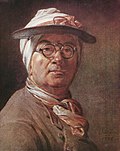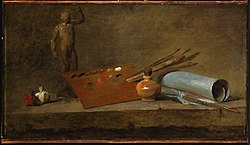Fichier:Chardin, Jean-Baptiste Siméon, Attributes of the Painter, ca. 1725-27.jpg

Fichier d’origine (2 000 × 1 162 pixels, taille du fichier : 329 kio, type MIME : image/jpeg)
Ce fichier et sa description proviennent de Wikimedia Commons.
Description
| Jean Siméon Chardin : Attributes of the Painter
|
||||||||||||||||||||||||||||
|---|---|---|---|---|---|---|---|---|---|---|---|---|---|---|---|---|---|---|---|---|---|---|---|---|---|---|---|---|
| Artiste |
artist QS:P170,Q207447 |
|||||||||||||||||||||||||||
| Titre |
English: Attributes of the Painter |
|||||||||||||||||||||||||||
| Type d'objet |
peinture object_type QS:P31,Q3305213 |
|||||||||||||||||||||||||||
| Description |
English: Catalogue Entry:
Chardin practiced an art form that, by tradition, was not of a high rank: in the academic hierarchy, still life was placed lower than history painting, portraiture, genre scenes, or even animal painting. Parisian by birth and at first apprenticed to history painters, Chardin found a vocation in the humble genre of still-life painting, although he also painted figural scenes of contemporary life, combining children or kitchen maids with still-life elements. As Chardin rose from shop-sign painter to member of the Royal Academy of Painting and Sculpture (where he was admitted to the ranks as a painter of still life in 1728), he gained the admiration of artists and collectors, and even the art critic Denis Diderot, who considered him a genius. These paintings, probably a pair of overdoors for a small study, testify to Chardin’s preternatural powers of observation and ability to render different substances in paint. They also are moral portraits of the owners of the tools, the artist and the architect. It has been noted that the dabs of paint on the palette are the colors used in the painting, as if the artist were providing a glimpse of his working practice. Attributes of the Painter includes a further wry, self-referential element in the small sculpture, which Jennifer Montagu has identified as a model by François Duquesnoy for the executioner holding up the head of John the Baptist in a sculpted tableau of the martyrdom of Chardin’s patron saint. Gallery Label: In the hierarchy established by the Royal Academy of Painting and Sculpture in ancien régime France, still-life painting ranked lower than history painting, portraiture, genre scenes, and even animal painting. Yet Chardin turned this apparent disadvantage into a strength, with collectors and critics delighting in the illusions of reality that he produced. His concern for creating a total visual experience through composition, spatial manipulation, color, and a loose painting technique led his contemporaries to observe that his still lifes—which, close up, read as a flurry of strokes—have a startling immediacy and naturalism. In Attributes of the Painter the artist’s palette shows the actual colors of pigments used in the painting, providing a record of the artist’s method of organizing his working tools. |
|||||||||||||||||||||||||||
| Date |
vers 1725 date QS:P571,+1725-00-00T00:00:00Z/9,P1480,Q5727902 -27 |
|||||||||||||||||||||||||||
| Technique / matériaux |
huile sur toile medium QS:P186,Q296955;P186,Q12321255,P518,Q861259 |
|||||||||||||||||||||||||||
| Dimensions |
hauteur : 50 cm ; largeur : 86 cm dimensions QS:P2048,50U174728 dimensions QS:P2049,86U174728 frame: hauteur : 70,8 cm ; largeur : 108,9 cm ; profondeur : 6,2 cm dimensions QS:P2048,70.8U174728 dimensions QS:P2049,108.9U174728 dimensions QS:P5524,6.2U174728 |
|||||||||||||||||||||||||||
| Collection |
institution QS:P195,Q2603905 |
|||||||||||||||||||||||||||
| Lieu actuel |
European Art |
|||||||||||||||||||||||||||
| Numéro d’inventaire |
y1935-4 |
|||||||||||||||||||||||||||
| Lieu de fabrication | France | |||||||||||||||||||||||||||
| Historique de conservation | ?Anonymous sale, Paris, May 15, 1879, lots 27-28; anonymous sale, Paris, April 19, 1880, lots 8-9; anonymous sale, Lair-Dubreuil, Paris, April 24, 1907, lots 13-14, to Flameng; François Flameng, Paris (1907–1919; sale, Galerie Georges Petit, Paris, May 26, 1919, lots 5-6); Jules Féral, Paris; Demotte, Paris and New York (in 1935; sold to Helen Clay Frick for Princeton University Art Museum). | |||||||||||||||||||||||||||
| Attribution de l’acquisition | Gift of Helen Clay Frick | |||||||||||||||||||||||||||
| Références |
|
|||||||||||||||||||||||||||
| Source / photographe | Princeton University Art Museum | |||||||||||||||||||||||||||
| Autorisation (Réutilisation de ce fichier) |
|
|||||||||||||||||||||||||||
Légendes
Éléments décrits dans ce fichier
dépeint
Attributes of the Painter anglais
image/jpeg
550f25c29ca80f0b11677dc4f9df78fe6f4285b3
336 569 octet
1 162 pixel
2 000 pixel
Historique du fichier
Cliquer sur une date et heure pour voir le fichier tel qu'il était à ce moment-là.
| Date et heure | Vignette | Dimensions | Utilisateur | Commentaire | |
|---|---|---|---|---|---|
| actuel | 12 janvier 2016 à 16:47 |  | 2 000 × 1 162 (329 kio) | Djkeddie | User created page with UploadWizard |
Utilisation du fichier
La page suivante utilise ce fichier :
Métadonnées
Ce fichier contient des informations supplémentaires, probablement ajoutées par l'appareil photo numérique ou le numériseur utilisé pour le créer.
Si le fichier a été modifié depuis son état original, certains détails peuvent ne pas refléter entièrement l'image modifiée.
| Commentaire de fichier JPEG | LEAD Technologies Inc. V1.01 |
|---|



